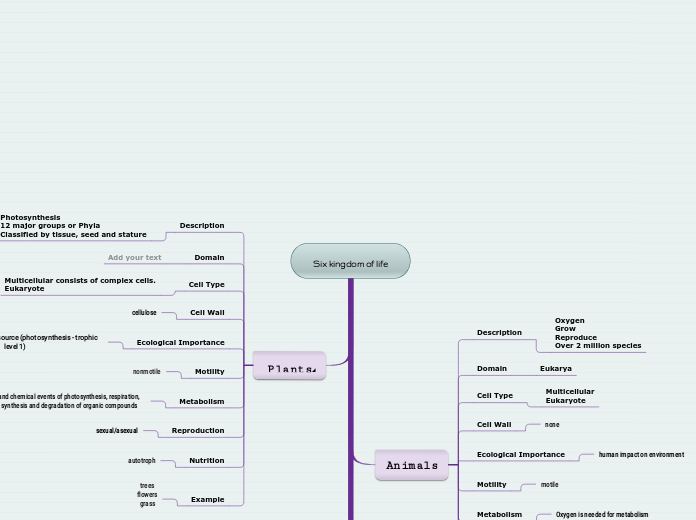Six kingdom of life
Animals
Description
Oxygen
Grow
Reproduce
Over 2 million species
Domain
Eukarya
Cell Type
Multicellular
Eukaryote
Cell Wall
none
Ecological Importance
human impact on environment
Motility
motile
Metabolism
Oxygen is needed for metabolism
Reproduction
Sexual reproduction occurs in most and asexual reproduction in some
Nutrition
Ingestion
Example
Mammals, amphibians, sponges, insects, worms
Fungi
Description
Fungi 'eat' by releasing enzymes to break down nutrients then absorb.
Fungi always live in and on their food.
Domain
Eukarya
Cell Type
Unicellular (yeast only)
Rest are multicellular
All Eukaryote
Cell Wall
chitin
Ecological Importance
decomposers
Motility
most nonmotile
Metabolism
Oxygen is needed for metabolism
Reproduction
Sexual or asexual through spore formation
Nutrition
Absorption
Example
Mushrooms, yeast, and molds
Archaebacteria
Description
Extreme salty water, sewer, acid, thermal
Microspcopic
3.5 billion years old
No oxygen
Domain
Archaea
Cell Type
Unicellular
Prokaryotes (simple cells no nucleus)
Cell Wall
contains uncommon lipids
Ecological Importance
decomposers
Motility
nonmotile
Metabolism
Depending on species, oxygen, hydrogen, carbon dioxide, sulfur, or sulfide may be needed for metabolism
Reproduction
Asexual reproduction by binary fission, budding, or fragmentation
Nutrition
Depending on species, nutrition intake may occur through absorption, non-photosynthetic photophosphorylation, or chemosynthesis
Example
Methanogens, halophiles, thermophiles, and psychrophiles
Plants^
Description
Photosynthesis
12 major groups or Phyla
Classified by tissue, seed and stature
Domain
Add your text
Cell Type
Multicellular consists of complex cells.
Eukaryote
Cell Wall
cellulose
Ecological Importance
major oxygen & food source (photosynthesis - trophic level 1)
Motility
nonmotile
Metabolism
physical and chemical events of photosynthesis, respiration, and the synthesis and degradation of organic compounds
Reproduction
sexual/asexual
Nutrition
autotroph
Example
trees
flowers
grass
Protists
Description
Odds and ends kingdom members are different
Domain
Eukarya
Cell Type
Unicellular and Multi cellular
All Eukaryote (Complex with nucleus and organelles)
Cell Wall
pectin or none
(green algae: cellulose)
Ecological Importance
algae major aquatic oxygen & food producers
algal bloom
Motility
motile/nonmotile
Metabolism
Oxygen is needed for metabolism
Reproduction
Mostly asexual, but meiosis occurs in some species
Nutrition
Depending on species, nutrition intake may occur through absorption, photosynthesis, or ingestion
Example
Amoebae, green algae, brown algae, diatoms, euglena, and slime molds
Eubacteria
Description
Live Everywhere, EXCEPT extreme environments, including in human.
Harmful and beneficial
Domain
Bacteria
Cell Type
Unicellular
Prokaryotes (simple cells no nucleus)
Cell Wall
peptidoglycan
Ecological Importance
fix nitrogen
decomposers
Motility
some motile
Metabolism
Depending on species, oxygen may be toxic, tolerated, or needed for metabolism
Reproduction
Asexual
Nutrition
Depending on species, nutrition intake may occur through absorption, photosynthesis, or chemosynthesis
Example
Bacteria, cyanobacteria (blue-green algae), and actinobacteria
